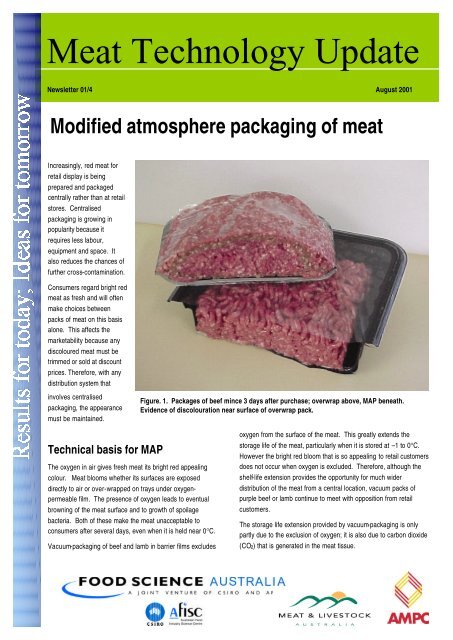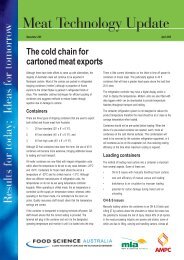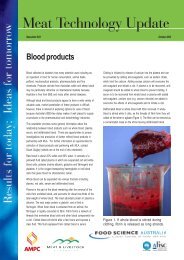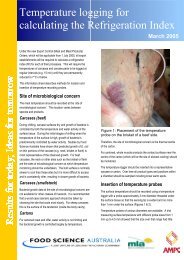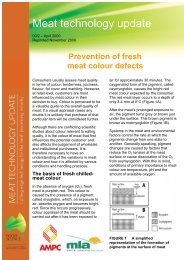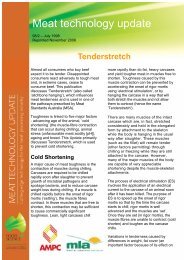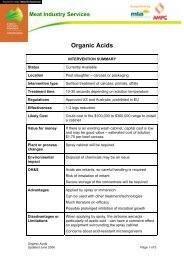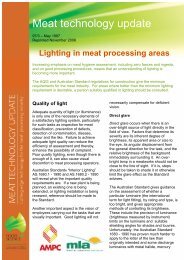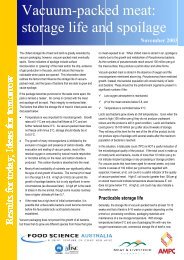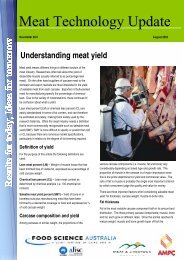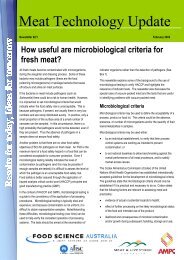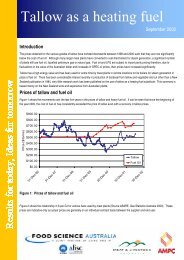Modified atmosphere packaging of meat. - Meat Industry Services
Modified atmosphere packaging of meat. - Meat Industry Services
Modified atmosphere packaging of meat. - Meat Industry Services
You also want an ePaper? Increase the reach of your titles
YUMPU automatically turns print PDFs into web optimized ePapers that Google loves.
The knowledge that CO2 inhibits bacterial spoilage <strong>of</strong> <strong>meat</strong> and thatoxygen is needed to give the bloom that appeals to retailcustomers, has led to the development <strong>of</strong> modified <strong>atmosphere</strong><strong>packaging</strong> (MAP) where relative proportions <strong>of</strong> gases in the packsare varied to achieve desired outcomes.The principal pigment <strong>of</strong> fresh <strong>meat</strong> is myoglobin, which can exist inthree main forms. Deoxymyoglobin is the deoxygenated form andis responsible for the purple colour <strong>of</strong> freshly cut <strong>meat</strong> or <strong>meat</strong>stored in the absence <strong>of</strong> oxygen, such as with vacuum packaged<strong>meat</strong>. When exposed to oxygen, deoxymyoglobin is rapidlytransformed into oxymyoglobin. This form <strong>of</strong> myoglobin isresponsible for the attractive bright red colour <strong>of</strong> <strong>meat</strong> typicallyassociated with freshness by consumers (Figure 1). The third form,metmyoglobin, is brown and is irreversibly formed through theoxidation <strong>of</strong> myoglobin. Consumers relate the presence <strong>of</strong> thisbrown colour to the loss <strong>of</strong> freshness and are reluctant to purchasethat particular product. Final <strong>meat</strong> colour is determined by therelative proportions <strong>of</strong> the three forms <strong>of</strong> myoglobin present at thesurface <strong>of</strong> the <strong>meat</strong>The main gases used in MAP are oxygen, carbon dioxide andnitrogen. Oxygen and carbon dioxide are <strong>of</strong> most significance inMAP <strong>meat</strong> and the relative proportions <strong>of</strong> each <strong>of</strong> them affectchanges in <strong>meat</strong> colour and microbiological quality.When exposed to O2, fresh <strong>meat</strong> will exhibit the bright red colourcharacterised by oxymyoglobin formation. However, lowconcentrations <strong>of</strong> O2 – around 0.5 to 1% - lead to rapid onset <strong>of</strong>irreversible browning. These conditions must be avoided by eitherkeeping the O2 at much higher levels or by excluding it.The role <strong>of</strong> CO2 is primarily to inhibit the growth and metabolism <strong>of</strong>microorganisms. CO2 selectively inhibits the growth <strong>of</strong> gramnegativespoilage bacteria, and, in doing so, may allow otherbacteria such as lactic acid bacteria to predominate. The lacticacid bacteria cause spoilage only after extended periods.Nitrogen is used as an inert gas filler. It provides no benefit to theproduct in terms <strong>of</strong> bactericidal or bacteriostatic effects but helpsmaintain the structural integrity <strong>of</strong> the package when carbon dioxideis absorbed into the <strong>meat</strong>. The use <strong>of</strong> nitrogen has no direct effecton <strong>meat</strong> colour.An important consideration with the use <strong>of</strong> CO2 in MAP is that it ishighly soluble in muscle and fat tissue. It will dissolve into the <strong>meat</strong>in an approximate 1:1 ratio (1 litre CO2 per kg <strong>of</strong> <strong>meat</strong>). Thesolubility <strong>of</strong> CO2 is temperature dependent and increases at lowertemperatures. Headspace calculations must take the solubility <strong>of</strong>CO2 into account when planning the <strong>packaging</strong> parameters. Whenusing a CO2-rich mixture in packs, the ratio <strong>of</strong> the total packagevolume (in litres) to the <strong>meat</strong> weight (in kilograms) is dependent onthe gas mix composition and could be up to 3:1 for mixtures inwhich CO2 predominate .In practice, with packs containing high O2 and moderate CO2, acompromise between that ideal and a tolerable pack size meansratios are usually somewhat lower. A minimum <strong>of</strong> 20% CO2throughout the storage period should be aimed for as explainedlater. The fact that CO2 can be either generated from <strong>meat</strong> asmentioned earlier, or absorbed into it, means that the concentration<strong>of</strong> CO2 in packs can vary depending on such factors as its initialconcentration in the mixture and the storage temperature.Packaging optionsThree main types <strong>of</strong> <strong>packaging</strong> approaches exist for modifying theenvironment in retail packs <strong>of</strong> fresh <strong>meat</strong>:• Vacuum / vacuum skin <strong>packaging</strong>;• high O2 MAP;• low O2 MAP.The three approaches differ in their preservative capabilities and theirapplicability to the centralised <strong>packaging</strong> <strong>of</strong> retail <strong>meat</strong>.The term MAP is usually reserved for procedures where air thatsurrounds the <strong>meat</strong> is replaced with gas mixtures that differ incomposition from air. Vacuum-<strong>packaging</strong> is the most commonmethod <strong>of</strong> modifying the internal environment <strong>of</strong> a package, howeverit has not been considered in detail here because it does not fit withinthis meaning <strong>of</strong> MAP.Vacuum / vacuum-skin <strong>packaging</strong>During conventional vacuum <strong>packaging</strong>, product is placed in apackage <strong>of</strong> low O2 permeability, the air is evacuated and the packageis sealed without replacement with another gas mixture. Over time,an environment containing elevated levels <strong>of</strong> CO2 will develop as the<strong>meat</strong> product and contaminating microorganisms consume residualO2 and produce CO2. The <strong>meat</strong> is purple in appearance howeverand therefore unappealing to many consumers. However, a range <strong>of</strong>beef, pork and lamb products in heavily printed and decorated bags,that are vacuum packed and put straight on the retail shelf have metwith good consumer acceptance.Vacuum-skin barrier packs are an alternative to conventional vacuum<strong>packaging</strong> for retail portions. A further enhancement <strong>of</strong> this approachis to use special peelable films. In these systems, air is evacuatedand packs are sealed using an O2-permeable film overlain with apeelable O2-impermeable film to maintain the oxygen-freeenvironment <strong>of</strong> the pack. Prior to retail display, the outerimpermeable film is removed and the <strong>meat</strong> blooms on exposure toair.High O2 MAPThe concept <strong>of</strong> packing fresh red <strong>meat</strong> under high concentrations <strong>of</strong>O2 to retard metmyoglobin (browning) formation has been recognisedfor many decades. High concentrations <strong>of</strong> O2 are used to increasethe amount <strong>of</strong> oxymyoglobin at and beneath the surface <strong>of</strong> the <strong>meat</strong>tissue and a bright red colour. This high O2 concentration does notinhibit the growth <strong>of</strong> aerobic spoilage organisms. The growth rate <strong>of</strong>the aerobic spoilage organisms can be reduced by the addition <strong>of</strong>moderate amounts <strong>of</strong> CO2 to the gas mixtures. When the CO2content <strong>of</strong> a gas mixture exceeds 20%, the rate <strong>of</strong> growth <strong>of</strong> themicrobial population is approximately halved. Therefore, an
<strong>atmosphere</strong> <strong>of</strong> around 80% O2 and at least 20% CO2 is beneficialfor both microbiological quality and <strong>meat</strong> colour. In practiceatmospheric mixtures <strong>of</strong> 60-80% O2 and 20-40% CO2 arecommonly used.The use <strong>of</strong> high O2 MAP is suitable for products that are to be heldfor short periods <strong>of</strong> time and in which a bright red colour is mostdesirable throughout the display life. Temperature control is criticalto the success <strong>of</strong> this application. Poor control will lead to growth <strong>of</strong>spoilage organisms and premature browning <strong>of</strong> the <strong>meat</strong>.Low O2 MAPLow O2 MAP is aimed at exploiting fully the inhibitory effects <strong>of</strong> CO2on spoilage bacteria and is used on products that are to betransported long distances or stored for several weeks. Productsmay be gassed with CO2 alone although the water and fat solubilitycharacteristics <strong>of</strong> CO2 <strong>of</strong>ten require the addition <strong>of</strong> N2 to prevent thepack collapsing. Gas mixtures used in this type <strong>of</strong> MAP will <strong>of</strong>tencontain greater than 65% CO2 with the residual as nitrogen.Despite the obvious drawback <strong>of</strong> the purple <strong>meat</strong> colour, it ispossible to use this technology in the centralised <strong>packaging</strong> <strong>of</strong> retail<strong>meat</strong> cuts. The retail cuts can be placed in pre-formed plastic traysand after air has been replaced with the gas mixture, a dual-layerfilm is applied to seal the pack. The dual layer film consists <strong>of</strong> apeelable O2 impermeable film that when removed after the packs <strong>of</strong>product have been stored, exposes an O2 permeable film thatallows the <strong>meat</strong> to ‘bloom’. This process allows retail <strong>meat</strong> cuts tobe stored for much longer periods <strong>of</strong> time prior to display than highO2 MAP and thereby lends itself for centralised production systems.However there are reservations about this system because it cantake some hours for the <strong>meat</strong> to bloom sufficiently to put on retaildisplay.Master <strong>packaging</strong> is a system that also enables centralised<strong>packaging</strong> <strong>of</strong> fresh beef cuts. In this technique, severalconventional retail packs wrapped in gas-permeable film, areplaced in a large high-barrier bag and typically filled with a highCO2 <strong>atmosphere</strong>. At the retail level, the outer bag is opened andpacks removed to allow the <strong>meat</strong> to bloom. Extended storage andretail display-life have been achieved using this system and it isbeing used more widely.<strong>Meat</strong> TypesThere are considerable differences between the storage life anddisplay life <strong>of</strong> <strong>meat</strong> from different species. Beef, lamb and porkhave differing susceptibility to chemical and microbial spoilage.Packaging systems <strong>of</strong>fer various possibilities depending on theparticular conditions that are chosen, but all depend on changingthe <strong>atmosphere</strong> within which the <strong>meat</strong> is packaged.Beefconsequence, the use <strong>of</strong> vacuum <strong>packaging</strong> in retail marketing islimited.Whilst vacuum <strong>packaging</strong> currently dominates the <strong>meat</strong> distributionsystem, the use <strong>of</strong> MAP for fresh retail-ready beef continues toincrease rapidly throughout the world with the US predicting that by2003, 50% <strong>of</strong> ground beef sold in the US will be sold in case readyformat. MAP for retail incorporates high levels <strong>of</strong> O2 and CO2 toachieve acceptable colour and shelf-life. High O2 MAP mixtures <strong>of</strong>60-80% O2 and 20-40% CO2 are commonly used and a display life <strong>of</strong>5-8 days can be achieved. High O2 MAP systems are thereforeuseful for centralised production facilities supplying directly to localmarkets.The use <strong>of</strong> low O2 MAP for beef is not recommended, as the <strong>meat</strong>will discolour at low O2 concentrations. However, MAP systems thatemploy oxygen-free gas mixtures <strong>of</strong> 50-90% CO2 and 10-50% N2 anddouble layer peelable film can provide extended storage and shelflife. Storage <strong>of</strong> up to 40 days followed by up to 4 days retail displaycan be achieved using this approach.LambAs with beef, consumers prefer lamb to have a bright red colourduring retail display and for this reason MAP systems that use lowlevels <strong>of</strong> O2 are not used for retail packs.Vacuum <strong>packaging</strong> and flushing using CO2 enables packaged lambto have a fresh/chilled storage life <strong>of</strong> up to 16 weeks at –1 to 0°C,with acceptable display life. This compares with a maximum <strong>of</strong> 8-10weeks with conventional vacuum-<strong>packaging</strong>.High O2 systems remain the first choice for the MAP <strong>of</strong> consumercuts <strong>of</strong> lamb. However, growth <strong>of</strong> certain spoilage bacteria (e.g. B.thermosphacta, S. putrefaciens and psychotrophicEnterobacteriaceae) at the high pH <strong>of</strong> some lamb <strong>meat</strong> (= 5.8) limitsits display life. The use <strong>of</strong> MAP systems for lamb cuts at the retaillevel has consequently met with limited success to date.PorkUnlike beef and lamb the colour <strong>of</strong> pork is relatively insensitive tooxidative deterioration at low O2 concentrations. Therefore low O2MAP can be used with pork. It should not, however, be used withpork <strong>of</strong> pale, s<strong>of</strong>t, exudative (PSE) quality as the low residual O2concentrations cause the <strong>meat</strong> colour to rapidly deteriorate.Low O2 MAP is used extensively for bulk <strong>packaging</strong> <strong>of</strong> pork primalcuts. Storage life <strong>of</strong> over 12 weeks at 0°C is possible when usinghigh CO2 MAP systems. This storage life is much greater thanvacuum-packaged pork, which will typically spoil within 8 weeks bylactic acid bacteria.As with beef, high O2 MAP is used for the retail display <strong>of</strong> consumercuts <strong>of</strong> pork. Provided the skin and excess fat is removed from theproduct, storage times equivalent to high O2 MAP beef are possible.Consumer preference for the bright-red colour in fresh beef is amajor factor in determining the way beef is packaged. As a
Safety <strong>of</strong> MAPConcerns have been expressed that the increase in shelf-life <strong>of</strong>low-O2 MAP <strong>meat</strong>s through inhibition <strong>of</strong> spoilage bacteria mayprovide sufficient time for human pathogens to grow to dangerouslevels while the food still remains attractive to the consumer.Clostridium botulinum is <strong>of</strong> most concern because <strong>of</strong> the severity <strong>of</strong>illness it causes and because <strong>of</strong> its ability to grow at high levels <strong>of</strong>CO2 and in the absence <strong>of</strong> O2. Some strains <strong>of</strong> C. botulinum areknown to produce toxins at temperatures below 4°C. Whilst there isa potential risk, problems can be avoided by ensuring thatextended storage <strong>of</strong> the packs routinely occurs at or near 0°C.Pathogens that are able to multiply at chill temperatures such asListeria monocytogenes and Yersinia enterocolitica are also <strong>of</strong>concern in MAP <strong>meat</strong> products. Both <strong>of</strong> these organisms arecapable <strong>of</strong> slow growth at temperatures as low as 0°C, but areinhibited significantly by high levels <strong>of</strong> CO2. Above 8°C, otherpathogens capable <strong>of</strong> tolerating high levels <strong>of</strong> CO2 such asSalmonella spp. and enterohaemorrhagic Escherichia coli (EHEC)may pose a risk to the consumer. However, as with other chilled<strong>meat</strong>s, under no circumstances should MAP product be held atmore then 5 o C. Temperature abuse is the most important extrinsicfactor influencing the storage life <strong>of</strong> fresh <strong>meat</strong>, whatever the<strong>packaging</strong> system.MAP <strong>of</strong> fresh <strong>meat</strong>s is generally considered less hazardous thanMAP <strong>of</strong> ready-to-eat foods because cooking (if correctly carriedout) will kill all vegetative pathogens. However, microbiologicalcontamination is a concern and MAP is not a substitute for poorhygiene and the greatest <strong>of</strong> care should be taken when producingMAP fresh <strong>meat</strong>s.Any <strong>packaging</strong> technology is only effective if high standards <strong>of</strong>hygiene and temperature control are maintained.Where to from here?Exciting times await those who are able to harness the potential <strong>of</strong>MAP technology. Future developments will centre on active, smartor intelligent <strong>packaging</strong> such as O2 scavenging from package<strong>atmosphere</strong>s, CO2 control by generation or absorption, controlledrelease <strong>of</strong> antimicrobial preservatives, and time-temperatureintegrator tags. Customer resistance to environmentally unfriendly<strong>packaging</strong> systems and demands for biodegradable <strong>packaging</strong> islikely to increase. The correct balance between storage / shelf lifeand the environment must be achieved.The drive towards centralised production, <strong>packaging</strong> and distribution<strong>of</strong> case-ready <strong>meat</strong>s will inevitably lead to further developments inMAP. It is important however to remember that the effectiveness <strong>of</strong>MAP fresh <strong>meat</strong> is reduced if <strong>meat</strong> <strong>of</strong> poor microbiological quality isused. Consideration must be given to the type <strong>of</strong> <strong>meat</strong>, thedeteriorative processes to which the <strong>meat</strong> is subject, the initialmicrobiological quality <strong>of</strong> the product, and the temperature historythat the product might experience during <strong>packaging</strong>, storage anddistribution. Knowledge <strong>of</strong> all aspects <strong>of</strong> MAP is essential and whenused effectively can give storage and retail display lives for chilledfresh <strong>meat</strong> that just 20 years ago seemed impossible.Further InformationAn information advisory package covering <strong>packaging</strong> can beobtained from MLA by contacting Matt Bishop on (02) 9463 9233.The information contained herein is an outline only and should not be relied on in place <strong>of</strong> pr<strong>of</strong>essional advice on any specific matter.For more information, contact one <strong>of</strong> the <strong>Meat</strong> <strong>Industry</strong> <strong>Services</strong> staff listed below.Food Science Australia <strong>Meat</strong> <strong>Industry</strong> <strong>Services</strong> SectionThe <strong>Meat</strong> <strong>Industry</strong> <strong>Services</strong> (MIS) Section <strong>of</strong> Food Science Australia is an initiative supported by <strong>Meat</strong> and Livestock Australia (MLA) and theAustralian <strong>Meat</strong> Processor Corporation (AMPC) to facilitate market access for, and support world-class practices in, Australia ’s <strong>meat</strong> industry.Need additional information help, information or advice?Contact any <strong>of</strong> the followingIan Eustace Bill Spooncer Neil McPhail Jocelyn Midgley Chris SentanceFood Science Australia Food Science Australia Food Science Australia Food Science Australia PO Box 178PO Box 3312 PO Box 181 PO Box 3312 PO Box 3312 FLAGSTAFF HILLTINGALPA DC QLD 4173 KURMOND NSW 2757 TINGALPA DC QLD 4173 TINGALPA DC QLD 4173 SA 5159Telephone 07 3214 2117 Telephone 02 4567 7952 Telephone 07 3214 2119 Telephone 07 3214 2109 Telephone 08 8370 7466Facsimile 07 3214 2103 Facsimile 02 4567 8952 Facsimile 07 3214 2103 Facsimile 07 3214 2103 Facsimile 08 8370 7566Mobile 0414 336 724 Mobile 0414 648 387 Mobile 0414 336 907 Mobile 0414 647 231 Mobile 0419 944 022Past copies <strong>of</strong> this newsletter can be obtained from: www.<strong>meat</strong>update.csiro.au


